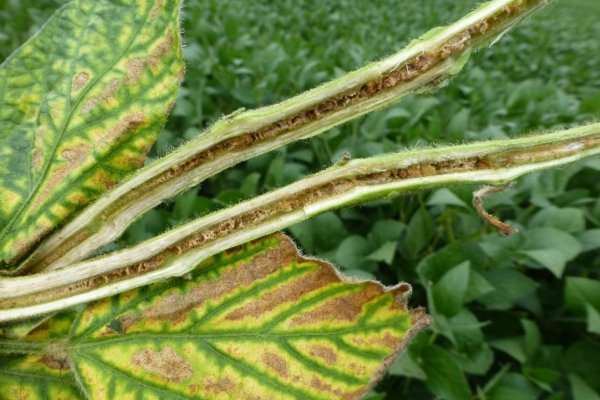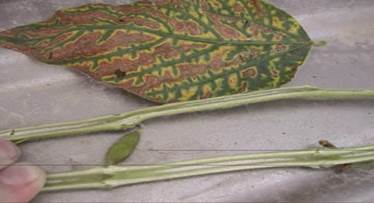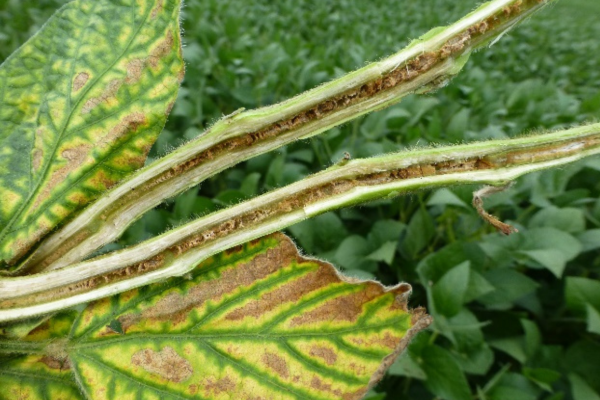
Identifying Late-Season Soybean Diseases
SUDDEN DEATH SYNDROME
Foliar symptoms of sudden death syndrome (SDS) have appeared in some local soybean fields this past week. Yield losses from SDS in past years such as 2008 and 2018 of note, have ranged from slight to nearly 100% in affected areas of fields and are dependent on disease onset and severity. This year’s onset is considered higher than normal by calendar, but late from a plant development standpoint.
SDS SYMPTOMS
SDS is caused by the soilborne fungus, Fusarium virguliforme (formerly known as Fusarium solani f. sp. glycines). Disease symptoms usually appear after flowering and during pod fill. Foliar symptoms begin as small yellow spots on the upper leaves. Spots gradually enlarge and develop a brown necrotic center, while the interveinal tissues are killed (see below). A green vein pattern will remain on the leaves until they defoliate. Unlike a soybean plant infected by brown stem rot, a SDS infected soybean should have a white, decay-free pith (see below). Infected plants often have increased flower and pod abortion and reduced seed size and quality.
SDS can affect entire fields of soybeans, but usually begins as scattered areas within a field. Unfortunately, if SDS symptoms appear, there is no treatment for the current year’s crop.
SDS DISEASE CYCLE
SDS is favored by high-yield environments and is especially prevalent in years when cool temperatures occur prior to or during flowering and pod set. High soil moisture during vegetative growth also favors the disease, as was the case this season in July. SDS is usually most severe in saturated soils, such as in low spots or in areas prone to ponding. Compacted areas such as around field entrances or where grain carts drove in the previous year may also exhibit more severe SDS symptoms. In addition, moderate to high populations of soybean cyst nematode usually, but not always, are associated with SDS and may increase the severity of SDS.
SDS MANAGEMENT
If SDS is present, little can be done this year; however, management decisions for 2024 can be developed. Fungicides are not an option for SDS control due to the nature and timing of the disease.
An integrated management plan for SDS may include the following:
- Balance the overall disease package. In most years, SDS is not a major disease; therefore, balancing the disease package in next year’s crop is better than focusing on SDS tolerance, especially since soybean fields from 2023 will likely not be soybean fields in 2024.
- Plant soybeans that are described as resistant or moderately resistant to soybean cyst nematode. Consult the 2023-2024 DEKALB® and Asgrow® Brand Seed Resource Guide for SDS and soybean cyst nematode tolerance ratings.
- Delay planting or plant earlier maturing varieties to possibly help soybeans escape infection from SDS.
- Cultural practices that improve drainage in low spots, reduce soybean cyst nematode populations, or remove soil compaction layers can lessen SDS severity.
ADDITIONAL LATE-SEASON SOYBEAN DISEASES
Soybean diseases such as brown stem rot (BSR), charcoal rot, Rhizoctonia stem rot, and Phytophthora root rot which can also cause early senescence. From a distance, the symptoms of yellow or chlorotic soybeans appear similar in the field. The first symptoms to appear are yellow or chlorotic areas in between the leaf veins that turn tan to brown. Eventually, plants will defoliate early leaving stems, petioles, and pods. Determining which pathogen is responsible can be a challenge, but, essential in forming a preventative plan for when affected acres return to soybean production.
Here are some key characteristics to look for to determine which disease may be causing the problem:
- Sudden death syndrome is caused by Fusarium solani f. sp. glycinea. The tap root is very discolored and there are few, if any, secondary roots. A blue stain may be present on the root. The pith is white. As leaves drop, petioles will remain attached to the plant.
- Brown stem rot foliar symptoms are similar to sudden death syndrome, but the tap root is not discolored. When stems are split, the pith is intact but chocolate brown in color. Leaves will wither and stay on plants.
- Charcoal rot is associated with high soil temperatures. Light gray or silverish lesions first develop on the tap root. Microsclerotia will form under the epidermis of the stem tissues, giving it a grayish-black color resembling a “sprinkling of finely powdered charcoal”.
- Rhizoctonia stem canker will have a brick-red sunken lesion at the base of the stem.
- Phytophthora stem rot symptoms include a dark brown discoloration of the stem progressing up from ground level. Internally, the stem pith will be discolored
Dr. John McNamara // Wilbur-Ellis Agronomist



